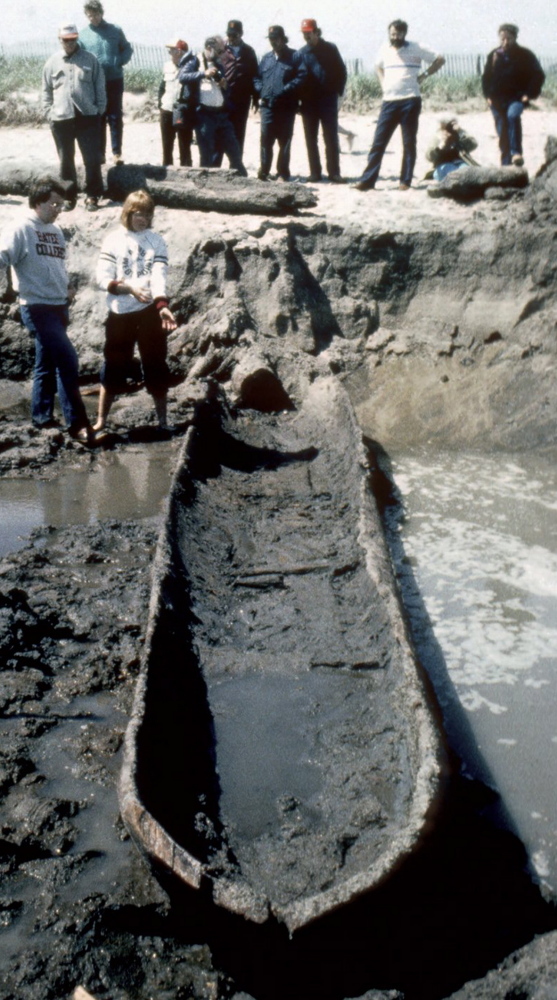An 18th-century canoe unearthed nearly 30 years ago in Biddeford Pool is finally on its way home to the city of Biddeford.
The Biddeford Finance Committee last week agreed to contribute $3,000 toward the cost of bringing home the canoe, believed to be among the oldest ever found in Maine. The canoe has languished in storage at Plimoth Plantation in Massachusetts since it was discovered and excavated from the beach at Biddeford Pool in 1986.
The canoe was nearly forgotten even by the volunteers and archaeologists who scrambled to uncover it between high tides 28 years ago. The 21-foot vessel, believed to be carved from a single tree, was hoisted onto a truck and taken to Massachusetts for a conservation process that was never completed. Jeff Cabral, director of the McArthur Library in Biddeford, last year launched an effort to find a way to bring the canoe back to the city and put it on permanent display. He said the canoe is believed to be one of the oldest – if not the oldest – boats found in Maine and is an important piece of Biddeford’s history
“I never lost hope that we would be able to bring the canoe back to its rightful place,” Cabral said. “I have always felt strongly that it is a significant artifact and piece of history, and not only that, it is a craft, a functional piece of art that served an actual purpose. One of our earliest settlers, or perhaps even a family, created this, most likely as a working vessel to fish from and support/sustain their loved ones. Why shouldn’t we treat it with the same care?”
But where the canoe will be displayed has not been determined.
The Saco Museum, Maine Maritime Museum and the Maine State Museum have turned down offers to take the canoe. Mayor Alan Casavant said it may be tricky to find a spot to display such a large piece, but he’s confident it will end up either in a public building or in a private building where it will still be accessible to the public.
“It’s a museum piece,” he said. “I don’t want it locked away so that no one can ever see it.”
The canoe will be moved to Biddeford by Pro Moving of Waterville, which specializes in the moving of antiques and artwork. Shape Fabrication and Marine Ecological in Biddeford will construct an acrylic display case. The strapping in the case will allow the canoe to be pieced back together in a simulation of its original shape, Cabral said.
The canoe was first noticed in June 1984 by Aldo Pulito, who lived in Biddeford Pool, after a strong storm washed sand away from the beach. Steve Podgajny, who at the time was director of the Saco Museum, scrambled to assemble a team of volunteers and archaeologists to dig out the canoe. It was immediately taken to an archaeological conservation laboratory where the process to conserve the waterlogged vessel was started but never finished. How it ended up in storage at Plimoth Plantation is unclear.
Emerson “Tad” Baker, a historical archaeologist who was involved heavily with the excavation, said last year that the canoe was carved from a single pine or cedar. More testing is needed to determine the type of wood and accurately date the vessel, but Baker believes it dates to the 1700s.
Baker said the fact the canoe survived makes it rare, but its significance is greater than that: The canoe is similar to the ones made by Native Americans, but the wood shows tool marks and indications the boat had a rudder, bridging the gap between the styles of the natives and the early settlers. The canoe was likely abandoned in an area that, at the time, was a saltwater marsh.
Last year, Cabral arranged for Jon Brandon, a conservator at East Point Conservation Studio in Brunswick, to examine the canoe. About 60 percent of the canoe remains intact and could be moved to Biddeford with minimal damage, Brandon said in a report prepared for Cabral.
Cabral said he’s thankful the city decided to fund the move and preserve a piece of the city’s history.
“It illustrates a real passion for the project,” he said. “Local history does matter and, as proven time and time again, historic preservation, whether of boats or homes, is a significant driver of economic development.”
Send questions/comments to the editors.




Success. Please wait for the page to reload. If the page does not reload within 5 seconds, please refresh the page.
Enter your email and password to access comments.
Hi, to comment on stories you must . This profile is in addition to your subscription and website login.
Already have a commenting profile? .
Invalid username/password.
Please check your email to confirm and complete your registration.
Only subscribers are eligible to post comments. Please subscribe or login first for digital access. Here’s why.
Use the form below to reset your password. When you've submitted your account email, we will send an email with a reset code.